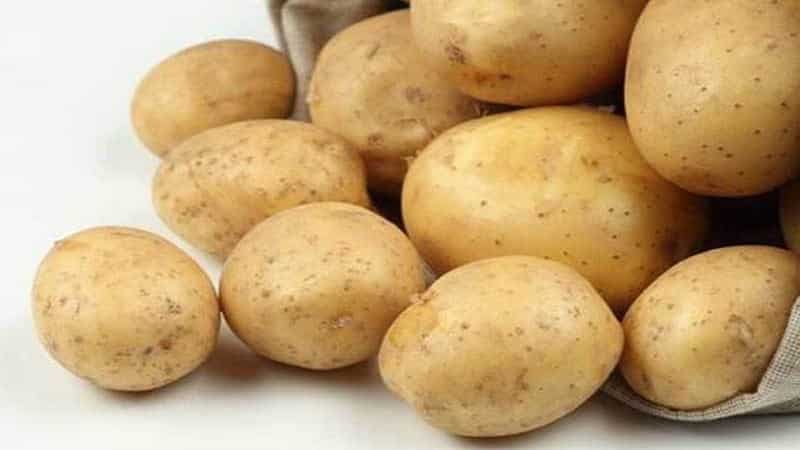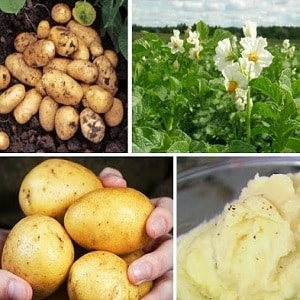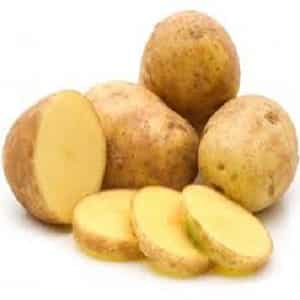Potato variety "Adretta" from German breeders
The mid-early German variety Adretta is a godsend for those looking for low-maintenance potatoes with high yields and excellent taste. Tubers are valued for their high starch content, due to which during cooking they become soft and slightly crumbly.
In the article we will talk about the advantages and disadvantages of the variety, the rules of cultivation, harvesting, storage and methods of treating the most dangerous diseases - late blight, black and common scab.
Origin and description of potatoes
The Adretta variety is a product of breeding work by German biologists of the company Norika Nordring-Kartoffelzucht und Vermehrungs GmbH, dated 1977. The culture was included in the Russian state register in 1980.
Patent holders:
- FGBNU "VNII Potato Farming named after. A. G. Lorkha";
- Federal State Budgetary Institution "Federal Research Center Institute of Cytology and Genetics of the Siberian Branch of the Russian Academy of Sciences";
- LLC Small Innovative Enterprise Far Eastern Center for Potato Selection and Seed Production.
The photo shows Adretta potatoes.

Several decades ago, yellow-fleshed potatoes were fed to farm animals. Its taste was not up to par. In the late 70s of the twentieth century, German breeders made a splash by creating Adretta potatoes with yellow flesh and a pleasant taste. It was this quality that determined the growth of the variety’s popularity, which it has not lost to this day.
The botanical description of the variety is presented in the table.
| Indicators | Characteristic |
|---|---|
| Ripening period | 60–80 days |
| Bush | Tall, erect, prone to profuse flowering |
| Number of tubers in a bush | On average 10–15 pcs. (maximum 25) |
| Weight | 100–150 g |
| Form | Round-oval |
| Coloring | The peel is yellow with small eyes, rough, the flesh is light yellow. |
| Leaves | Large, light green color |
| Corolla color | White |
| Starch content | 13–18 % |
| Taste | Excellent (5 on a five-point scale) |
| Cooking class/group | C (medium crumbly) |
| Productivity | 400–460 c/ha |
| Marketability | 95 % |
| Keeping quality | 98 % |
| Purpose | Dining room |
| Sustainability | Immunity to cancer and viruses, susceptibility to late blight, common scab, rhizoctonia. |
| Transportability | High |
Agricultural technology varieties
The Adretta variety is unpretentious in care and withstands drought and cold snaps. The crop is planted on loose sandy and loamy soils. 200–300 kg of sand per 100 m² is added to peat soil, and heavy loam is lightened with humus (500 kg per 100 m²). When planting, preference is given to open, well-lit areas.
Potatoes need regular watering, loosening, weeding, hilling, mineral fertilizing, and preventive spraying against pests and diseases.
Dates, scheme and rules of planting
Potatoes are planted in the last ten days of April - mid-May. In 20–25 days, the tubers are taken out of the cellar to a warm, bright place for germination. The seeds are pre-soaked in the growth stimulator "Epin", and then kept for 20-30 minutes in a slightly pink solution of potassium permanganate, "Fitosporin" or copper sulfate.
The area is prepared for planting in the fall - it is dug up and fertilized with humus. In the spring, they loosen again and form holes 8–10 cm deep with an interval of 35–40 cm. The row spacing is 50–60 cm.
Place 1 tbsp in each hole. l.mullein and superphosphate. The tubers are divided into parts so that each of them has 1–2 eyes. This ensures high productivity. The cut is sprinkled with wood ash and the material is laid with the sprouts facing up. Next, the holes are covered with earth and the beds are leveled with a rake.
Care
Adretta potatoes cope with drought, but do not tolerate stagnant water in the soil. The bushes are watered from a watering can as needed, after the top layer of soil has dried. Consumption per plant - 3–4 liters. In dry, hot weather, sprinkling is carried out.

The beds are loosened after each watering to prevent the formation of a hard earthen crust.
Hilling up potato bushes is a mandatory procedure, which helps retain moisture, saturate the soil with oxygen, and form tubers. Hilling is carried out twice during the growing season: the first - when the bushes reach 8-10 cm in height, the second - 20 cm. Before the procedure, the soil is moistened. All manipulations are carried out in the morning or evening due to the negative effects of the sun on the bushes.
When feeding Adretta potatoes, nitrogen fertilizers are applied carefully. In the case of this variety, a deficiency is better than an excess, otherwise the plant will begin to actively gain vegetative mass, and the tubers will grow small.
Potato bushes are fed depending on their appearance:
- Thin and weak shoots and limp leaves indicate a lack of minerals. For feeding, use 15 g of urea/10 l of water or an infusion of chicken manure (500 ml/10 l). Consumption per plant - 500 ml.
- During the budding period, add a second portion (3 tablespoons of ash, 1 tablespoon of potassium sulfate per 10 liters of water). Consumption per bush - 500 ml.
- A third additional portion of fertilizer is applied at the height of flowering to stimulate tuber formation (100 g superphosphate/10 l or 2 g sodium humate/10 l).The solution is used for spraying plantings.
Nuances of cultivation and possible difficulties
Another method is used to grow potatoes: planting in the grass without digging the soil. In the selected area of grass, rows are marked using stakes and rope. The distance between the rows is 50–60 cm. Every 20–30 cm, lay out 2-3 tubers in a checkerboard pattern. Cover the top with hay or straw with a layer of 30 cm.
During the growing season, mown grass is poured onto the beds, constantly renewing the layer of mulch. The slop that is poured between the rows serves as fertilizer.
Diseases and pests
Adretta potatoes are susceptible to late blight of tubers and foliage, common scab and rhizoctonia. The table contains information about the signs of diseases and treatment methods.
| Disease | Signs | Treatment | Prevention |
|---|---|---|---|
| Late blight | Dark spots and whitish coating on the leaves, gray rot on the tubers, wilting of the plant. | Spraying with Bordeaux mixture, Ridomil Gold, Oksikhom, Alufit, Bravo. | Crop rotation, treatment of tubers before planting with Fitosporin, potassium permanganate, fertilizing with potassium-phosphorus fertilizers, monitoring the level of nitrogen in the soil. |
| Common scab | Wet and dry rot on tubers. | Acidification of the soil before planting with ammonium sulfate (2 tbsp/10 l).
Spraying plants with Maxim, Albit, Colfugo, Acrobat MC, Mankozeb, Ordan. |
Timely watering, fertilizing with copper, manganese and boron, spraying with Zircon, which suppresses spore growth.
|
| Rhizoctonia (black scab of tubers) | Dark, deep spots, reticular tissue death. | Treatment with drugs Maxim, Quadris. | Compliance with crop rotation, fertilization with potassium and phosphorus, timely harvesting.
|
Fungicides help fight the Colorado potato beetle:
- "Fitoverm";
- "Prestige";
- "Aktara";
- "Corado";
- "Taboo";
- "Killer";
- “NO Colorado potato beetle!”
Traditional methods:
- dusting with cornmeal in the morning, on leaves damp from dew for better adhesion;
- Leave 1 kg of green fruits or walnut leaves/10 liters of hot water for 7 days, strain before use;
- 100 g of dry elecampane roots / 5 liters of hot water, leave for 3 hours and spray the bushes;
- Pour 0.5 kg of sunflower flowers into 10 liters of water and leave for 3 days;
- 1.5 kg of celandine/10 liters of boiling water, leave for 3 hours, add 1 liter of 1.5% calcium chloride solution.
Cicadas, the main carriers of fungal diseases, feed on potato leaves. To destroy the pest, birds are attracted to the site, and the bushes are treated with the preparations “Prestige”, “Tabu”, “Akarin”, “Calypso”, “Decis”.
Collection, storage and use of crops
Harvesting is carried out in a timely manner - from late August to mid-September, since ripe tubers begin to rot in damp soil. Seed material is renewed after 3–5 years.
The collected tubers are laid out in a dark room to dry for 3-4 days, then laid out in wooden, plastic boxes, or linen bags. The optimal indoor air temperature is +2 °C, humidity is 80–85%.
Advice. To prevent potatoes from sprouting, place a few apples in the boxes.
On a balcony or loggia, potatoes are stored in boxes that are placed on stands so that they do not come into contact with the icy floor, or in thermal containers (large backpacks powered by electricity).
Tubers are regularly inspected and sorted, completely removed from storage. Rotten and green fruits are thrown away.
Adretta potatoes have a pleasant taste.A characteristic feature is that as a result of freezing it does not acquire a sweetish taste. The product is suitable for boiling, frying, baking and stewing. Due to the high starch content, the tubers quickly fall apart in water, so they are steamed to preserve their structure.
This is interesting:
Do potatoes cause gas and why does it make your stomach swell?
The mid-early table potato variety Gourmet is purple in color.
Advantages and disadvantages
The advantages of Adretta potatoes include:
- rapid growth of green mass;

- early maturation;
- excellent taste;
- when frozen, the pulp does not become sweet and does not change color;
- resistance to viruses and cancer;
- ease of care.
Among the disadvantages:
- in drought, when there is a lack of moisture, the tubers stop growing;
- When stored in a room with high humidity, potatoes germinate.
Growing regions
The variety has received permission for cultivation in the following regions:
- Middle Volga (Penza, Samara, Ulyanovsk regions, Republic of Mordovia and Tatarstan);
- West Siberian (Altai Territory, Altai Republic, Kemerovo, Omsk, Novosibirsk, Tyumen, Tomsk regions);
- Far Eastern (Amur, Kamchatka, Magadan, Sakhalin regions, Primorsky and Khabarovsk territories).
Adretta is also cultivated in other regions of the country, observing the rules of agricultural technology. With proper care, a large harvest can be harvested in regions with a warm, dry climate.
Farmer reviews
Over the several decades of its existence, the Adretta variety has won the love of farmers and consumers, thanks to its guaranteed high yield, pleasant taste and ease of care.
Pavel, Nizhny Lomov: “The German variety Adretta has been considered one of the best for many years.I have been growing it on my plot for a long time and every time I get excellent results. After cooking, the tubers are soft, slightly crumbly, tasty, even if they freeze in winter, they do not become sweet.”
Nina, Kolyvan: “We have been growing potatoes on hay for five years in a row. For us this is the simplest and most effective way. There is no need to dig the ground and then hill up. Plants do not get sick, they are not chewed by Colorado plants. The Adretta variety, as always, is at its best. The tubers are smooth, with yellow skin and pulp.”
Oksana, Komsomolsk-on-Amur: “Everyone seems to know this German productive variety. Many people grow it in our region, including me. Potatoes have a pleasant taste, do not degenerate for a long time, but are not resistant to late blight, black and common scab. I advise you to buy seeds from trusted manufacturers, so you will be confident in the quality of the material and get the expected result.”
Read also:
Recipes for homemade potato face masks against wrinkles.
Conclusion
The Adretta potato has not lost its leadership position for several decades in a row, since its inception. The smooth yellow tubers have a pleasant taste, are stored for a long time in a cool place, do not freeze and are suitable for frying, boiling, stewing and baking.
The culture has a strong immunity to cancer and viruses, but is not resistant to late blight, black and common scab. Preventive measures (crop rotation, treating seeds in potassium permanganate or copper sulfate, timely harvesting and applying potassium-phosphorus fertilizers) help prevent or at least minimize the likelihood of infection.